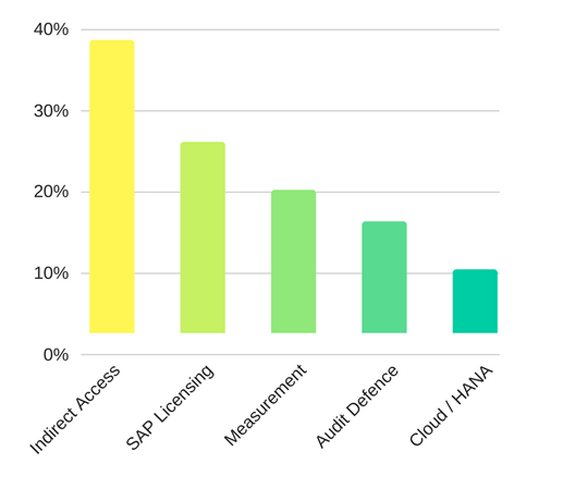Drinks company Diageo lose battle with SAP, indirect access continues to wreak havoc

Special cocktail: SAP mixes up £58m Indirect Access bill for drinks group Diageo. Diageo is a British multinational alcoholic drinks company. HQ is in London, It is the world’s largest producer of spirits and a major producer of beer. £10BN Revenue, 33K Employees.
The UK High Court has ruled in favour of SAP who sued the global drinks company Diageo in a dispute over indirect licensing, reports Computer Weekly.
SAP claimed that technology connected to SAP infrastructure via Salesforce.com warranted a named user license for everyone accessing the service.
High court ruling:
- SAP claim they are entitled to £54m in additional license fees, the court will rule the exact figure at a later date.
- The basis of SAP’s case is that a “A named user is an individual representative of Diageo or a group company, or a supply chain third party, who is authorized to use or access the software directly on indirectly”
- Diageo’s defence argued that the license purchased for the SAP PI product was a “gatekeeper” for gaining access to SAP infrastructure.
My opinion:
- A software industry dinosaur (SAP) has been able to continue it’s restrictive and uncompetitive practices
- Suing it’s own customers over indirect access, whilst not defining how to architect indirect access and also promoting the benefits of Internet of things is comparable to entrapment, a honeytrap (see also IT Pro: SAP – can licensing keep pace with IoT)
- SAP have got away with not having to define indirect access properly in accordance with modern technology innovation
- I suggest the judgment lacks technological know-how. If I have a Payroll system and buy 100 users, and I use a printer to print the pay cheques, do I need to buy an additional 100 payroll system licenses because I’m sending data to the printer?
What can we learn from this judgment?
How can IT Asset Managers learn from this expensive judgment:
- SAP has a vague interpretation of indirect access. Diageo has an interpretation of a “gateway” concept. Neither of which was nailed down in the contract.
- The contract is with a software industry dinosaur using audits to prop up stagnant revenues with single digit % of customers going to HANA.
- For an audit dependent dinosaur like SAP – If you can’t measure it, don’t install it. Easy for me to write, difficult to do, but for Diageo there are 58 million reasons to do ITAM.
SAP Special Interest Group
Meanwhile, thanks to all those who volunteered to join our SAP special interest group. The group entry is now closed and oversubscribed.
A quick poll of end user organisations found SAP indirect access the top priority followed by a general understanding of SAP Licensing, how to measure consumption, audit defence and moving to the SAP cloud / HANA.

Is there anything in particular you would like to discuss or learn about regarding SAP?
Q. Is there anything in particular you would like to discuss or learn about regarding SAP? (n=47)
- 31.9% Indirect Access (Costs, how to counter claims during the next audit, impact of future connected devices, architectural guidelines, adding indirect disclaimer to existing SAP agreements)
- 25.5% General SAP Licensing, trends, new license models, engines, users, perpetual
- 19.1% Measurement & Optimisation (Reading LAW files and identifying licensable modules, reporting strategy for user licensing, secondary use rights)
- 14.9% Audit defence (Keeping audits away, the SAP compliance organization, highest risks, global perspectives, contractual requirements, negotiation outcomes)
- 8.5% Moving to cloud / hana
Stay tuned to The ITAM Review newsletter for updates from the SAP special interest group members.
What is your view on this judgement? Join the conversation on The ITAM Review forum here:
Image source: Diageo.
Related articles:
SAP's Digital Access Adoption Programme (DAAP) aims to kickstart indirect licensing decisions
Windows 8 Licensing Quick Guide
MPs claim zero tax payments by Oracle, Dell, CSC, Xerox, Symantec
Microsoft Licensing in the Cloud 'As Complicated as Ever'
SAP Digital Access Adoption Program (DAAP) set to expire
Former UK MD of Snow Software joins Campaign for Clear Licensing as CEO
- Tags: 1_SAP_MR · Diageo · Indirect Access · SAP · SAP audit · SAP Licensing
About Martin Thompson
Martin is also the founder of ITAM Forum, a not-for-profit trade body for the ITAM industry created to raise the profile of the profession and bring an organisational certification to market. On a voluntary basis Martin is a contributor to ISO WG21 which develops the ITAM International Standard ISO/IEC 19770.
He is also the author of the book "Practical ITAM - The essential guide for IT Asset Managers", a book that describes how to get started and make a difference in the field of IT Asset Management. In addition, Martin developed the PITAM training course and certification.
Prior to founding the ITAM Review in 2008 Martin worked for Centennial Software (Ivanti), Silicon Graphics, CA Technologies and Computer 2000 (Tech Data).
When not working, Martin likes to Ski, Hike, Motorbike and spend time with his young family.
Connect with Martin on LinkedIn.

Trackbacks